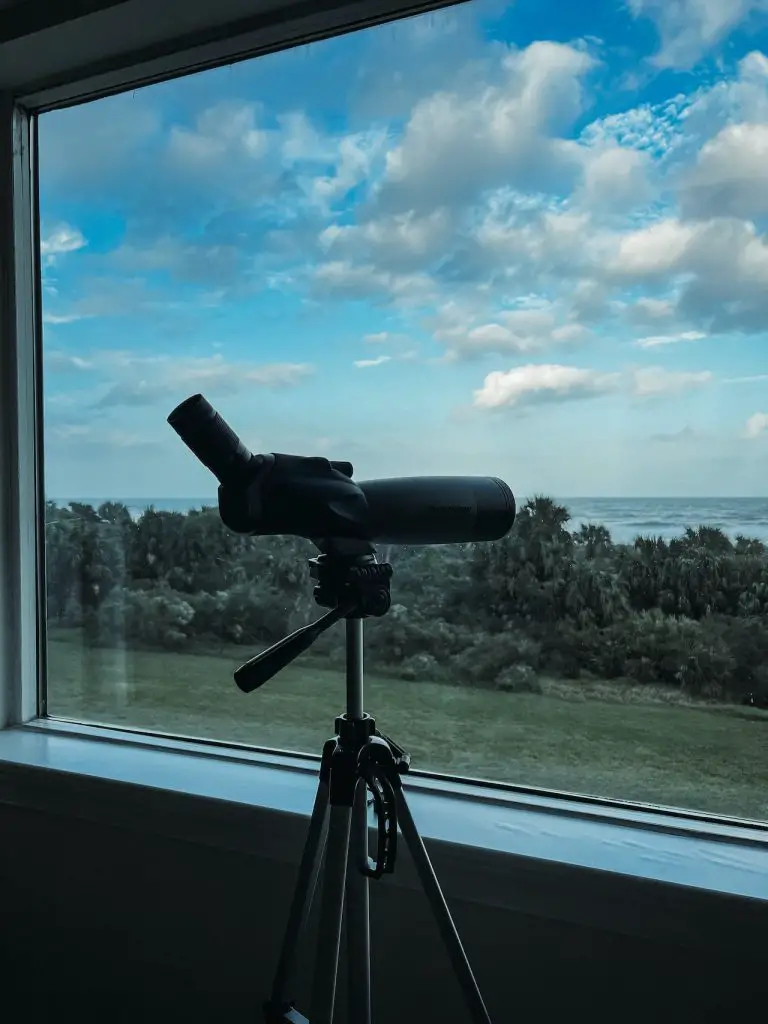Can Binoculars See Through Clouds?

Wouldn’t it be amazing to see beyond the clouds? Unfortunately, it’s just wishful thinking. Many people wonder if it’s possible to observe through clouds with binoculars.
The answer is a resounding no.
Despite this, some still believe that binoculars can reveal objects that are hidden by clouds. To understand why this is not the case, let’s review some basics.
Understanding Visibility Through Clouds
To understand whether binoculars can see through clouds, we need to first understand how clouds affect visibility.
Clouds are made up of tiny water droplets or ice crystals that scatter light in all directions. This scattering effect can reduce contrast and cause objects to appear blurry or hazy.
The thickness and altitude of the cloud, as well as the size and concentration of the droplets or crystals, can all affect how much light is scattered and how much detail is lost.
Other factors that affect visibility through clouds include the amount of ambient light, the color of the object being viewed, and the type of cloud.
For example, cumulus clouds (the puffy white clouds often seen on a sunny day) may have less of an impact on visibility than stratus clouds (the flat, grey clouds that can cover the sky)

Can Binoculare See Through Clouds?
Clouds can pose a challenge for amateur and professional binocular users who want to observe the wonders of nature, birds, or distant objects.
Unfortunately, we cannot control the weather, and clouds can obstruct our view.
As we learned earlier, the ability of binoculars to penetrate clouds depends on several factors such as the thickness and type of clouds, the amount of ambient light, and the magnification and aperture of the binoculars.
Just like our eyes, binoculars gather light and focus it on our eyes.
This means that if we cannot see through the clouds with our naked eyes, we cannot see through them with binoculars either.
Moreover, the sensitivity of binoculars to turbulence or particles in the air is greater than that of the naked eye. This makes it more challenging to observe through clouds with binoculars.
However, some binoculars, such as those with lower magnification and larger apertures, may still be able to provide some detail through thin, high-altitude clouds.
The effectiveness of binoculars in observing through clouds varies depending on the conditions, and observing nearby objects or clouds themselves can still be enjoyable and interesting.
Check: Best Astronomy & Stargazing Binoculars
Here are some examples of when binoculars can or cannot see through clouds:
- On a bright day with scattered cumulus clouds, binoculars may be able to penetrate the clouds and provide clear views of distant objects.
- On a cloudy day with thick stratus clouds, binoculars may not be able to penetrate the clouds and provide clear views.
- When observing stars or planets through thin, high-altitude clouds, binoculars may still be effective in providing some detail.
- When observing birds or other objects against a cloudy sky, binoculars may be less effective in providing clear views due to the scattering effect of the clouds.
It’s worth noting that even when binoculars are not able to penetrate the clouds, they can still be useful for observing nearby objects or for observing clouds themselves.
Clouds can be fascinating to observe, with their constantly changing shapes and patterns.

Can A Telescope See Through Clouds?
Unfortunately, telescopes cannot see through clouds.
Why?
Because again, as Binoculars, Telescopes work similarly to our eyes, so if we can’t see through the clouds, neither can the telescope. Clouds scatter and absorb light, reducing the clarity and brightness of the object being observed.
Moreover, telescopes are highly sensitive to turbulence and particles in the air.
Any obstruction, even a thin layer of clouds, can have a significant impact on the quality of the observation. This can make it challenging to obtain sharp and detailed images, especially for those using high magnification.
There are, however, certain types of telescopes, such as radio telescopes, that can penetrate through clouds.
Radio waves are able to travel through clouds without being scattered or absorbed, allowing these telescopes to observe certain celestial objects that are otherwise obstructed by clouds.
However, these telescopes are highly specialized and not commonly used by amateur astronomers.
Can Binoculars Be Used To See Through Fog?
Binoculars can be used to see through fog to a certain extent. However, their effectiveness is limited by the density and thickness of the fog.
Fog consists of tiny water droplets suspended in the air, which scatter and absorb light. This results in reduced visibility and image contrast, making it difficult to distinguish objects in the distance.
Binoculars work by magnifying the image of the object you are viewing. This can be advantageous in foggy conditions as it can bring the object closer and enhance its details.
However, if the fog is too dense, even binoculars will not be able to penetrate it, resulting in a loss of visibility.
Can IR See Through Fog And Rains?
Infrared (IR) cameras detect heat signatures emitted by objects and convert them into images that we can see. However, the ability of IR to detect objects through water, fog, and clouds is limited.
Water is opaque to IR, which means that it cannot penetrate through it. Only the top layer of water can be seen through an infrared camera.
Therefore, any object that is submerged beneath the surface will not be visible to an IR camera. This can be problematic for applications such as underwater search and rescue or surveillance.
Similarly, clouds can prevent IR from penetrating through the layers to see what is inside. Clouds absorb and scatter infrared radiation, making it difficult for IR cameras to detect objects beyond them. As a result, IR cameras cannot see celestial objects that are obstructed by clouds, such as stars and galaxies.
Fog is another atmospheric condition that can interfere with IR imaging. Fog consists of tiny water droplets suspended in the air, which can scatter and absorb IR radiation.
This can result in a loss of image contrast and resolution, making it difficult to distinguish between objects of different temperatures.
To overcome these limitations, IR cameras are often equipped with features such as thermal contrast enhancement, which enhances image contrast in low-visibility conditions.
They may also be used in conjunction with other technologies such as radar and sonar to provide a more comprehensive picture of the environment.

What is the Best Time to Use Binoculars for Cloud-Gazing?
The best time to use binoculars for cloud-gazing is when the sky is partially cloudy or mostly clear with scattered clouds. In these conditions, the clouds will be well-defined and distinct, and you can use binoculars to observe their intricate details and shapes.
It is also important to choose the right time of day for cloud-gazing. The best time is during the morning or early afternoon when the sun is high in the sky. This provides ample light to illuminate the clouds, making it easier to observe their features and details.
Clouds are constantly changing, and their appearance can vary depending on the time of day and weather conditions.
For example, at sunset or sunrise, clouds can take on a beautiful pink or orange hue, creating a stunning visual display. However, during the middle of the day, the sunlight can create harsh shadows on the clouds, making it more difficult to observe their features.
Finally, it is important to choose a location with a clear view of the sky, away from trees, buildings, or other obstructions that can interfere with your observation. A location with a high vantage point, such as a hill or mountain, can also provide an unobstructed view of the sky.
You will find this interesting: Viewing Planets Through Binoculars
Conclusion
In conclusion, binoculars cannot see through clouds. This is because they work similarly to our eyes and are affected by the same factors that hinder visibility in cloudy conditions, such as light scattering and absorption.
Despite misconceptions to the contrary, binoculars are unable to reveal objects that are hidden by clouds.
It’s important for outdoor enthusiasts and nature lovers to Check the weather forecast and plan their observation sessions on clear days to maximize their chances of successful observation.
More Read:
